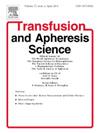IF 1.4
4区 医学
Q4 HEMATOLOGY
引用次数: 0
摘要
背景尽管在许多国家,在有了 RHD 基因分型技术后,使用抗人球蛋白试剂对 RhD 阴性捐献者进行弱 D 血清学检测以确定捐献者的弱 D 状态的做法已被淘汰,但在印度,这种检测仍是常规做法。然而,弱 D 检测是一个资源密集型的耗时过程。我们为 RhD 阴性献血者的弱 D 检测设计了一种新算法,即先进行 CcEe 表型分析,然后仅对 C+ 和/或 E+ 样本进行弱 D 检测,并将其与现有方案在时间和成本效益方面进行了比较。我们对现有算法和新算法进行了比较,并从检测结果、检测所需时间和总成本方面计算了两者的一致性。RhD 类型、弱 D 状态和 CcEe 表型均采用传统试管技术进行测定。吸附-洗脱试验用于检查 Del 表型。我们对所有弱 D 检测阴性的样本进行了 RHD 基因分型。结论在印度人群中,对于表型为 C 和 E 阴性的 RhD 阴性献血者,可以停止弱 D 检测,而只对表型为 C+ 和/或 E+ 的献血者进行弱 D 检测,这似乎是一种省时、省钱的检测策略。本文章由计算机程序翻译,如有差异,请以英文原文为准。
Weak D testing might be discontinued for RhD-negative blood donors with C and E negative phenotypes in the Indian population
Background
Although serological testing to determine weak D status using the antihuman globulin reagent has been phased out for RhD-negative donors in many countries after the availability of RHD genotyping, it is routinely performed in India. However, weak D testing is a resource-intensive and time-consuming process. We devised a new algorithm for weak D testing in RhD-negative blood donors by performing CcEe phenotyping followed by weak D testing in only C+ and/or E + samples and compared it with the existing protocol in terms of time and cost-effectiveness.
Method
In this observational study, we tested 500 samples of RhD-negative blood donors over one year in India. The existing and new algorithms were compared, and the agreement was calculated in terms of the test results, time required for testing, and total cost involved. The RhD type, weak D status, and CcEe phenotypes were determined using the conventional tube technique. An adsorption-elution test was performed to check for the Del phenotype. We conducted RHD genotyping for all samples negative for weak D testing.
Results
The proposed algorithm showed perfect agreement with the existing protocol (agreement = 100 %; κ= 1.00). By applying the new algorithm, we could reduce 71.63 % of testing time and 24 % of total cost without missing any weak D positive samples in blood donors.
Conclusions
Weak D testing might be discontinued for RhD-negative blood donors with C and E negative phenotypes in the Indian population and could be restricted to only C+ and/or E + phenotypes, which seems to be a time- and cost-effective testing strategy.
求助全文
通过发布文献求助,成功后即可免费获取论文全文。
去求助
来源期刊
CiteScore
3.60
自引率
5.30%
发文量
181
审稿时长
42 days
期刊介绍:
Transfusion and Apheresis Science brings comprehensive and up-to-date information to physicians and health care professionals involved in the rapidly changing fields of transfusion medicine, hemostasis and apheresis. The journal presents original articles relating to scientific and clinical studies in the areas of immunohematology, transfusion practice, bleeding and thrombotic disorders and both therapeutic and donor apheresis including hematopoietic stem cells. Topics covered include the collection and processing of blood, compatibility testing and guidelines for the use of blood products, as well as screening for and transmission of blood-borne diseases. All areas of apheresis - therapeutic and collection - are also addressed. We would like to specifically encourage allied health professionals in this area to submit manuscripts that relate to improved patient and donor care, technical aspects and educational issues.
Transfusion and Apheresis Science features a "Theme" section which includes, in each issue, a group of papers designed to review a specific topic of current importance in transfusion and hemostasis for the discussion of topical issues specific to apheresis and focuses on the operators'' viewpoint. Another section is "What''s Happening" which provides informal reporting of activities in the field. In addition, brief case reports and Letters to the Editor, as well as reviews of meetings and events of general interest, and a listing of recent patents make the journal a complete source of information for practitioners of transfusion, hemostasis and apheresis science. Immediate dissemination of important information is ensured by the commitment of Transfusion and Apheresis Science to rapid publication of both symposia and submitted papers.

 求助内容:
求助内容: 应助结果提醒方式:
应助结果提醒方式:


